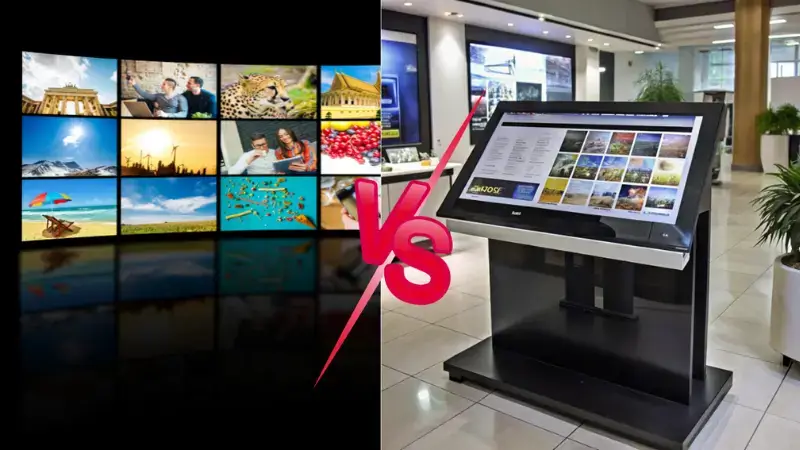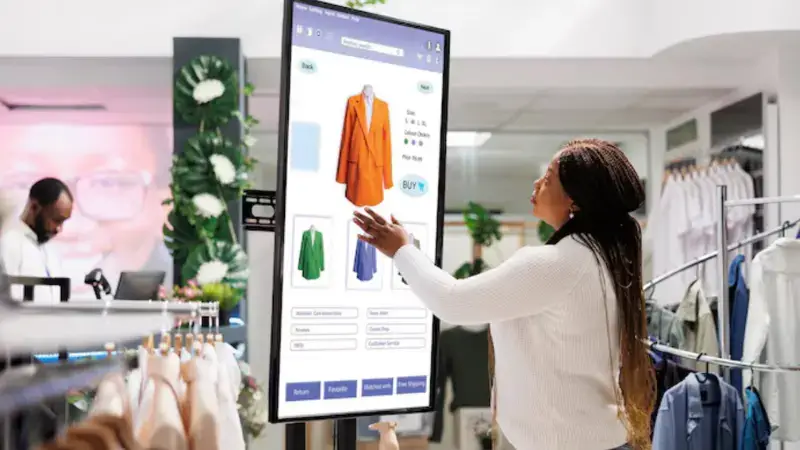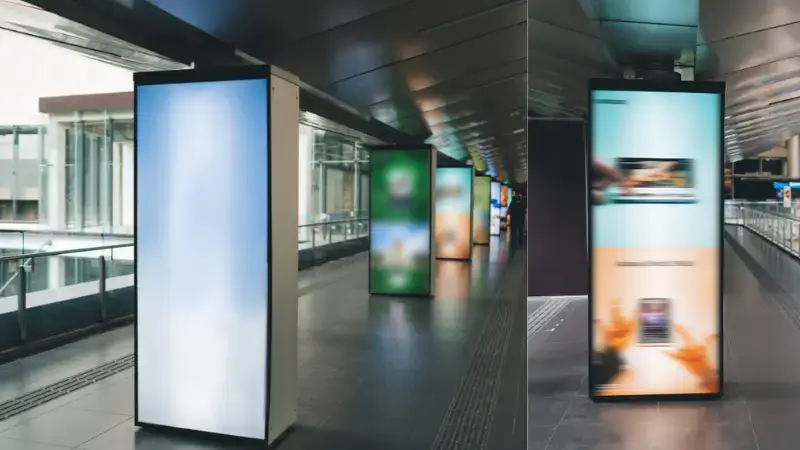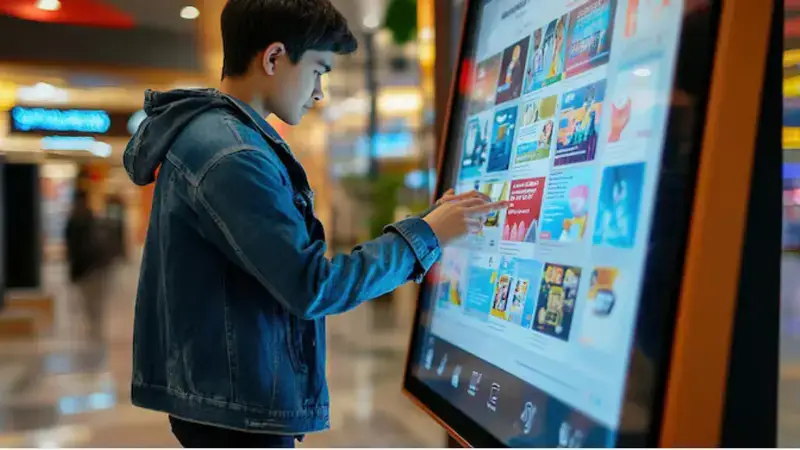You don’t hang a regular TV in a storefront window and expect results. Businesses that treat screens like marketing tools get more eyes, clicks, and sales. A digital signage TV is a commercial-grade display built for nonstop content, sharper visibility, and remote control.
This article explains how digital signage TVs differ from regular TVs, why they work better for advertising, and where they add the most value. It also provides a breakdown of costs, ROI, and tips on choosing the right display for your space.
What Is a Digital Signage TV, And Who Uses Them?

A digital signage TV is a commercial-grade display built for business use. It works all day, handles frequent content changes, and shows sharp visuals in bright or busy spaces.
Unlike a regular TV, it’s built to do more than play shows. It delivers real-time business messaging at scale.
Here’s how digital signage is different from a regular TV
- Built for nonstop use
Digital signage TVs run 16–24 hours a day without overheating or wearing out fast. Consumer TVs aren’t made for that.
- Brighter and more durable
These screens push higher brightness levels (500–2,500+ nits), resist glare, and survive in demanding conditions…heat, cold, dust, or crowds.
- Remote management
With built-in CMS support, you can update content on one screen or hundreds at once, without stepping on site.
- No extra gear needed
Many include a media player, Wi-Fi, and pro-grade inputs. You won’t need to attach third-party streaming sticks or USBs.
Where do businesses use them?
You’ve likely seen digital signage TVs without realizing it. They show up in:
- Retail stores – to promote sales or show dynamic product displays
- Quick-service restaurants – for digital menus and upsells
- Hospitals and clinics – for wait-time updates or patient instructions
- Corporate offices – for internal communications and visitor greetings
- Hotels – in lobbies for welcome screens or event listings
- Gyms and fitness centers – to play class schedules, brand videos, or live metrics
- Transportation hubs – like airports and train stations, for live departures and maps
Businesses use these screens to save time, stay consistent, and keep customers engaged.
The Difference Between Digital Signage and Regular TVs for Business Use

A regular TV can’t keep up with the demands of a business. Digital signage TVs are built to run longer, shine brighter, and stay reliable…even in tough settings.
Here’s how they compare with regular TVs.
Hardware & Display Capabilities
Digital signage TVs outperform regular TVs in every physical aspect.
- Brightness: Up to 2,500+ nits vs. 250–350 nits in standard TVs.
- Anti-glare coatings: Built to cut reflections in bright rooms or near windows.
- Temperature range: Handles extreme indoor and semi-outdoor conditions.
- Lifespan: Rated for 50,000 to 70,000 hours. That’s 3x longer than most consumer models.
Content and Software Functionality
Digital signage screens work with pro-grade software that puts content control in your hands.
They support CMS platforms like LG SuperSign, Samsung MagicINFO, and cloud-based tools that let you update content from anywhere.
Schedule content by time of day, day of the week, or run dynamic feeds. A regular TV just loops static media unless you plug in external devices every time.
Reliability and Performance
Digital signage doesn’t take breaks.
- Built for 24/7 use
- No image burn-in from static content
- Commercial warranty and priority support
Consumer TVs, on the other hand, are made for 6–8 hours of daily use and often void warranties when used in business settings.
A Quick Comparison of Digital Signage Vs Regular/Consumer TVs
| Feature | Digital Signage TV | Consumer TV |
|---|---|---|
| Brightness | 500–2,500+ nits | 250–350 nits |
| Runtime | 16–24 hrs/day | 6–8 hrs/day |
| Content Control | Cloud CMS + scheduling | Manual playback or looping |
| Durability | High-temp, dust, glare-tolerant | Indoor use only |
| Lifespan | 50,000–70,000 hours | 20,000–30,000 hours |
| Warranty Coverage | Commercial-grade, long-term | Limited, consumer use only |
How Businesses Use Digital Signage TVs
You’ve seen digital signage in action, whether you noticed or not. It shapes the customer experience, streamlines communication, and boosts clarity in high-traffic environments. Here’s how different industries use it to scale their businesses;
Retail and Shopping Malls
Stores use digital signage to boost foot traffic and influence buyer decisions. Window displays run time-limited deals, while in-store screens direct customers to trending items.
For example, a fashion chain might run hourly flash sales on screens near changing rooms. It increases conversions during peak hours.

Hospitality and Food Service
Restaurants, cafés, and quick-service outlets rely on digital signage for fast updates.
Digital menu boards show real-time pricing, seasonal items, or meal combos to encourage upsells.
A fast-casual burger chain can instantly switch menus between breakfast and lunch while pushing high-margin items during lunch rushes.
Corporate and Office Spaces
Offices use digital screens to streamline communication.
These screens reduce email clutter and improve internal updates, from meeting room availability to company news.
A tech company might display key KPIs on a digital dashboard in open workspaces, keeping teams aligned in real time.
Healthcare Facilities
Hospitals and clinics use digital signage to manage flow and reduce patient frustration. Waiting room screens provide estimated wait times and health tips, while hallway displays guide patients through large campuses.
A large urban clinic might use digital boards to alert visitors about appointment delays or direct them to specific labs or rooms.
5 Key Benefits of Digital Signage for Businesses

Businesses don’t invest in screens for decoration…they expect results.
Advertising monitors offer real, measurable value when used right. Here’s how they help businesses operate smarter, communicate better, and boost returns.
1. Draws More Eyes with Motion and Brightness
Static signs get ignored. Digital displays with motion, contrast, and high brightness pull attention, even in noisy, crowded spaces.
People naturally look at movement…it’s how we’re wired.
In retail, this means more foot traffic. In hospitality, it makes promos hard to miss. The result? Higher visibility and message recall.
2. Keeps Customers Engaged with Real-Time Interaction
Digital monitors can do more than show a message…they can respond to it.
- Touchscreen menus in restaurants speed up ordering.
- QR codes on product displays offer instant mobile access.
- NFC tags connect viewers to promos in seconds.
This adds convenience and builds a better user experience, without adding pressure on staff.
3. Adapts Messages Based on Time, Location, or Audience
With digital signage, you’re not stuck with one message all day.
- Show promos in the morning and happy hour in the evening.
- Push different content in different branches based on stock or audience.
- Launch campaigns across cities from one screen.
This level of targeting helps you stay relevant without printing a single flyer.
4. Reduces Workload Through Central Control
One dashboard can manage every screen in every location. Whether you’re updating menu boards across franchises or syncing schedules for corporate lobbies, digital signage takes hours off your team’s plate.
It reduces manual errors and speeds up how quickly you can react to business needs.
5. Cuts Printing Costs and Pays Back Fast
You stop reprinting posters every week. You stop paying for shipping, installs, and takedowns. That adds up.
Digital signage is an upfront investment, but studies show many businesses see ROI within 12–18 months. The ROI is higher in retail and QSR environments where updates are frequent.
How to Choose the Right Digital Signage Solution for Your Business

The right setup is the one that contains the hardware and software that meet your daily business needs. Here are some key factors that you must consider before buying a digital signage system for your business;
Display size and resolution
Choose screen sizes based on viewing distance. For most indoor use, 1080p works fine. But if you’re displaying detailed graphics or text-heavy visuals, 4K offers sharper clarity.
Indoor vs. outdoor needs
Outdoor displays need higher brightness (2,000+ nits), anti-glare coating, and weatherproof housing. Indoor displays can focus more on resolution and design flexibility.
CMS compatibility
Make sure the display supports a user-friendly CMS (Content Management System). You’ll need it for remote updates, content scheduling, and multi-screen control.
Compatibility with tools like LG SuperSign, Samsung MagicINFO, or Philips CMND makes a big difference.
Scalability
Whether you start with 2 screens or 20, choose systems that allow you to scale easily without needing to switch platforms or redo the setup.
Investment vs. Returns: Cost & ROI Breakdown

Upfront Costs
The initial cost of a digital signage setup depends on screen size, resolution, and build quality.
- Basic displays (43–55”) cost between $500–$1,500
- Premium outdoor screens or large-format walls can go above $5,000
Add installation and mounting expenses (typically $200–$500 per unit).
Expect ongoing maintenance like software updates, hardware checks, and occasional replacements.
Long-Term ROI
Digital signage pays off over time, both in visibility and savings.
- Retailers report up to 30% more foot traffic after switching from static posters to dynamic displays.
- Food chains like McDonald’s use digital menu boards to boost upsells and speed up decision-making at the counter.
- KFC saw increased order values by showing time-limited offers and combos via signage screens.
Other gains include:
- Lower printing costs — no more posters or flyers
- Faster content updates — edit promotions or alerts remotely
- Better internal communication — ideal for offices and warehouses
For multi-location businesses, a cloud CMS reduces time spent on manual updates. It helps marketing teams focus on strategy, not logistics.
Best Practices for Maximizing Impact With Digital Signage TVs

Here’s what works best if you want to get more out of your digital signage.
1. Content Must Stay Sharp and Useful
Keep content short, clear, and to the point. Use bold visuals and video to grab attention. Stick to one message per screen. Add a strong call to action. Highlight sales, new arrivals, or urgent info your customer needs to see. Outdated or cluttered displays turn people off.
2. Choose the Right Placement
Put screens where people naturally look.
- High-traffic zones.
- Eye-level height.
- Near checkouts, entryways, or seating areas.
Avoid glare from windows or lights. Don’t bury it in a corner. Great content in the wrong spot does nothing.
3. Keep the System Running Smoothly
Update the software. Replace any broken hardware fast. Use built-in analytics if your CMS has it. Track what content performs best. If one message works, try it in other locations too. Rotate content often to keep viewers engaged.
FAQs About Digital Signage and Regular TVs
What is the difference between digital signage and a smart TV?
A digital signage TV is built for 24/7 commercial use and includes a content management system (CMS) for remote updates. A smart TV is designed for home use, with limited brightness and durability. It has no business-grade content control.
How long does a digital signage TV last?
Most digital signage displays are rated for 50,000 to 70,000 hours of continuous use. This makes them ideal for businesses that need reliable, long-term operation without frequent replacements.
Can I use a regular TV as digital signage?
You can, but it comes with significant trade-offs. Consumer TVs aren’t built for extended runtime, lack remote content management, and usually void the warranty when used commercially. Businesses should use commercial-grade signage to ensure performance and support.
What size digital signage TV is best for business?
The ideal size depends on the viewing distance and space. For storefronts and large areas, 55″ to 75″ is common. For kiosks or tight spaces, 32″ to 43″ is often enough. Always factor in screen resolution and brightness based on the environment.
Do digital signage TVs require the internet?
Most digital signage TVs support both online and offline content. The Internet is needed for cloud CMS updates, remote scheduling, and real-time data. But you can also run preloaded content through USB or internal storage if needed.
Final Take: Why Digital Signage TVs Are the Smarter Business Investment
Digital signage is a business tool. Every message you show either builds interest or loses attention.
Traditional TVs weren’t built with that pressure in mind. Digital signage TVs were. They run longer, shine brighter, and let you control every screen from one place.
Whether you’re managing five stores or fifty, the ability to push targeted content instantly gives you an edge. Don’t treat your displays like afterthoughts. Use them to sell more, inform faster, and stay ahead.
Looking to upgrade your in-store presence?
Discover SwiftForce’s LG digital signage solutions designed for 24/7 performance and impactful results.
Contact us today to find the right setup for your business.



